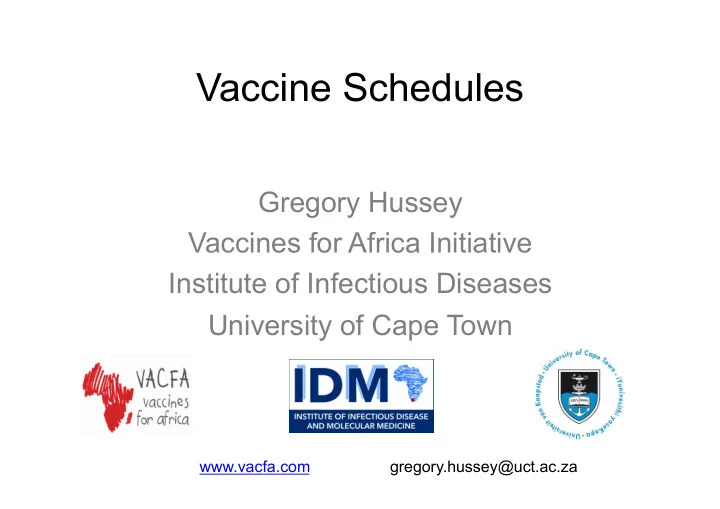

Vaccine Schedules Gregory Hussey Vaccines for Africa Initiative Institute of Infectious Diseases University of Cape Town www.vacfa.com gregory.hussey@uct.ac.za
Outline • What vaccines do we include. • When do we vaccinate. • Focus on EPI schedules. • Timeliness of vaccination. • Vaccination of pregnant women. • Information on private schedules.
http://www.who.int/immunization/ programmes_systems/ policies_strategies/ vaccine_intro_resources/nvi_guidelines/
http://www.who.int/immunization/ documents/positionpapers/en/
http://www.immunize.org/packageinserts/
http://www.who.int/immunization/policy/ immunization_tables/en/
Vaccines available for children in developed countries 25 20 15 10 5 0 1970 1980 1990 2000 2010
What vaccines do you include in your schedule?
Estimated Lowest Price* to purchase a full course of vaccines for a child up to 1 year of age, according to WHO Universal Recommendations^ $40.00 6) PCV $35.78 Purchased by GAVI $35.00 5) Rotavirus $30.00 Cost of following WHO $27.16 recommendations is rising! $25.00 USD $20.00 3) Hib 4) PCV $15.00 $11.11 $11.58 $11.04 $10.00 1) 2) Hepatitis Traditional B $5.00 $2.39 $2.23 $1.37 $1.40 $1.26 $0.00 2001 2002 2003 2004 2005 2006 2007 2008 2009 2010 Year MSF – The right shot
Vaccine costs for SA • BCG R4 • OPV R2 • Measles R8 • Hep B R16 • Hib / R408 DTP/IPV R160 • Rota R510 • Pneumo R700 • HPV R1808 • TOTAL
Ack: A Meheus, NESI
Ack: A Meheus, NESI
Factors that may influence seroprotection rates following vaccination • Age – elderly and very young / premature infants • Immune deficiency - HIV • Genetic factors • Dose of vaccine • Nutritional status – malnourished / vitamin A deficient • Route of administration – id vs im
Basic primary schedule – DTP based
Basic EPI schedule • Birth: BCG, HBV, OPV • 6, 10, 14 wks: DTP/Hib/HBV, OPV (include 1 dose of IPV after 14 weeks) • 9months: Measles, YF • 18 months: Measles • Pregnant women: TT
BCG Polio Diphtheria Tetanus Pertussis Hep B Measles Rota Pneumo HPV Change
Vaccination of pregnant women: tetanus WHO position paper on Tetanus vaccine
Vaccine effectiveness was 90% (95% CI 82 to 95) when the analysis was restricted to cases in children younger than 2 months.
Timeliness of vaccinations • Timely immunisation is crucial for direct protective effects during infancy and early childhood, when disease and mortality are highest. • Other vaccines, such as the new oral rotavirus vaccines, are currently recommended to be given before a child reaches a certain age, because of potential safety concerns in older infants. Lancet 2009
6w 14w 36w
Hepatitis B • The hepatitis B vaccine is recommended by WHO for universal implementation, and administration at the same time as BCG vaccine at or soon after birth. • Yet the median time of administration of BCG was beyond 1 week of age in more than 75% of countries surveyed by Clark and Sanderson.
Pertussis • The greatest burden of mortality due to pertussis is in the first 6 months of life and vaccine efficacy improves considerably with increasing doses. • Their survey found median coverage of the first dose (scheduled at 6–8 weeks) was 57% by 12 weeks of age, rising to 80% by 5 months, and for the third dose (scheduled at 14 weeks), coverage was 27% and 65% by 5 and 12 months, respectively.
Vaccination of Premature infants • The immune response to vaccination is a function of postnatal rather than gestational age. Transplacentally acquired maternal antibody is present in lower concentrations in prems and persists for shorter period. • Infants born prematurely, regardless of birth weight, should be vaccinated at the same chronological age and according to the same schedule and precautions as full-term infants and children. • Exception: HBV - Decreased seroconversion rates might occur among certain preterm infants with birth weights of less than 2,000 g after administration of hepatitis B vaccine at birth. DON’T COUNT HBV1 DOSE. • Several studies suggest that the incidence of adverse events after vaccination of preterm infants is the same as or lower than that of full-term infants vaccinated at the same chronological age.
Vaccination of ill infants • Mild illness is not a contra-indication for vaccination. • Postponing vaccination in children with minor febrile or afebrile illness constitutes a missed opportunity to protect a child from disease, can contribute to outbreaks of vaccine-preventable disease. • Vaccination usually is deferred in persons who have moderate or severe illness.
http://www.amayeza-info.co.za/wp-content/uploads/2011/08/2015- Newschedule-products-final-15102014.pdf
Conclusion Immunisation is an evolving science Vaccination schedules are not set in stone. Given the differences in epidemiology, health infrastructure and resources, it will be difficult to develop a single immunisation schedule for all countries. Optimising schedules for new vaccines could reduce cost and streamline their integration with other vaccines. WHO has recommended vaccination schedules; they are very useful, particularly in low- and middle-income countries.
Recommend
More recommend